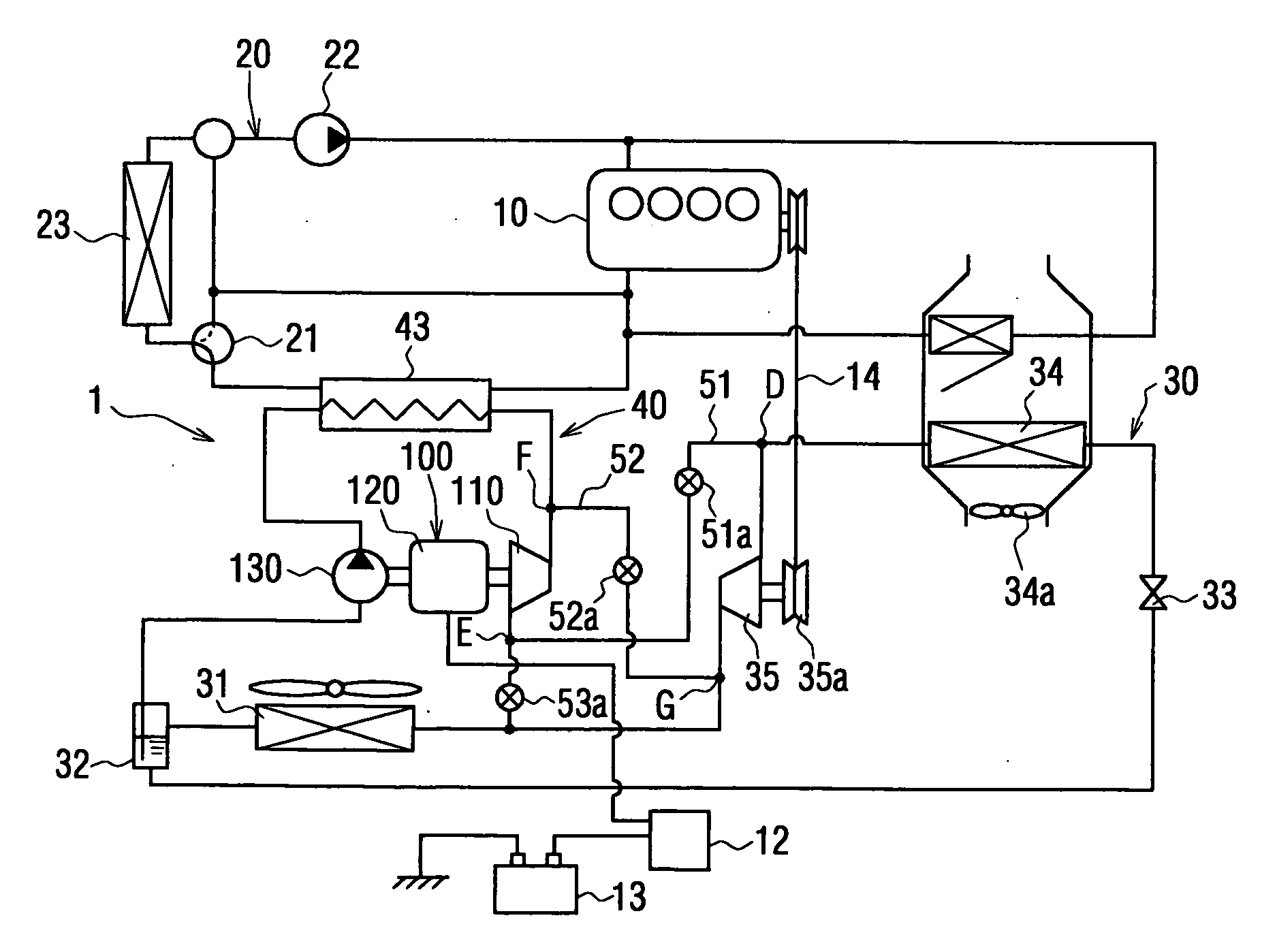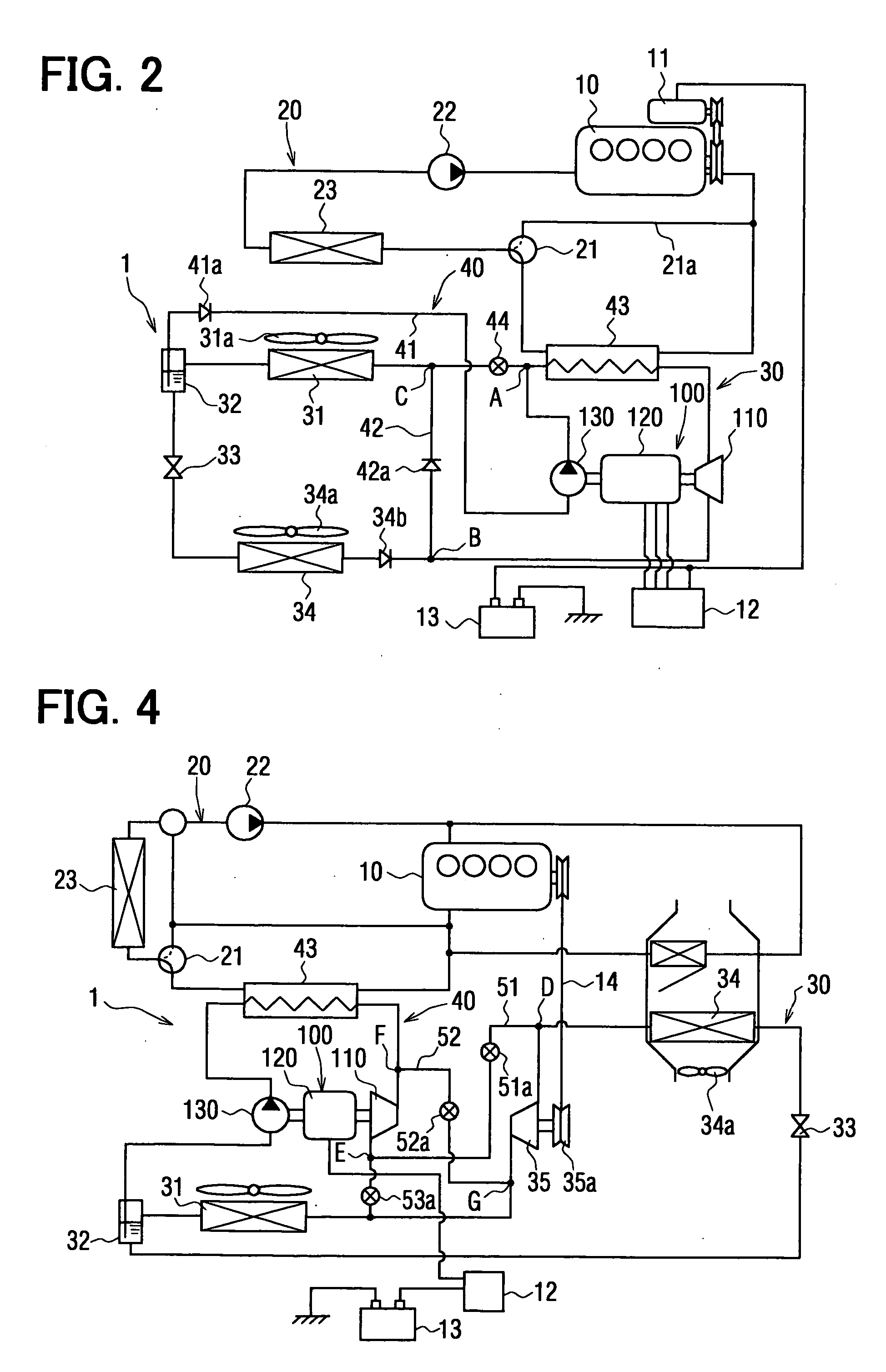Refrigerating apparatus and fluid machine therefor
a technology of refrigerating apparatus and fluid machine, which is applied in the field of refrigerating, can solve the problems of reducing the efficiency of the operation of the compressor by the driving motor, the inability to obtain the driving force by the expansion device, and the inability to efficiently utilize waste heat, so as to achieve the effect of effectively collecting and using waste heat and reducing the dead volum
- Summary
- Abstract
- Description
- Claims
- Application Information
AI Technical Summary
Benefits of technology
Problems solved by technology
Method used
Image
Examples
first embodiment
[0055] A first embodiment relates to an automotive air conditioning apparatus, wherein a complex fluid machine 100 of the present invention is applied to a refrigerating cycle 30 having Rankine cycle 40.
[0056] At first, a structure of the complex fluid machine is explained with reference to FIG. 1. The complex fluid machine 100 comprises an expansion-compressor device 110 having both functions of a compressor device and an expansion device, a motor generator 120 having both functions of an electric power generator and an electric motor, and a refrigerant pump 130.
[0057] The expansion-compressor device 110 has the same structure to a well-known scroll type compressor, and comprises a fixed scroll 112 provided between a front housing 111a and a motor housing 121, a movable scroll 113 facing to and rotated with respect to the fixed scroll 112, a discharge port 115 for communicating a working chamber V with a high pressure chamber 114, an inlet port 116, and a valve device 117 for ope...
second embodiment
[0112] A second embodiment is shown in FIG. 4, which differs from the first embodiment in that the air conditioning apparatus 1 is applied to a vehicle (e.g. an idle-stop vehicle, a hybrid vehicle), wherein an operation of the engine 10 is temporally stopped depending on a driving condition of the vehicle (such as, an idling operation, a low speed driving, and so on). The second embodiment further differs from the first embodiment in that a main compressor device 35 is provided in the refrigerating cycle 30, and connecting passages 51, 52 and ON-OFF valves 51a, 52a, 53a are provided.
[0113] As described above, the main compressor device 35 is provided in the refrigerant cycle 30, independently from the expansion-compressor device 110. The refrigerant cycle 30 of this embodiment comprises the main compressor device 35, the condenser 31, the gas-liquid separator 32, the evaporator 34, which are connected in a circuit.
[0114] The main compressor device 35 is provided with a pulley devi...
third embodiment
Modifications of Third Embodiment
[0184] A modification of the third embodiment is shown in FIG. 14, in which the projected portion 322c is further extended in its longitudinal direction so that its forward end projects into the discharge port 115. Furthermore, an inner diameter of the discharge port 115 on a side to the high pressure chamber 114 is made smaller than that of the other portion of the discharge port. The small diameter portion 115a of the discharge port 115 is designed at an optimum value for the flow amount of the refrigerant pumped out from the expansion-compressor device 110.
[0185] According to the above modification, the volume of the discharge port 115 for the compression mode can be reduced by the projected portion 322c, namely the dead volume of the discharge port 115 can be reduced. The small diameter portion 115a substantially functions as the discharge port.
[0186] Another modification of the third embodiment is shown in FIG. 15, in which the guide portion 3...
PUM
 Login to View More
Login to View More Abstract
Description
Claims
Application Information
 Login to View More
Login to View More - R&D
- Intellectual Property
- Life Sciences
- Materials
- Tech Scout
- Unparalleled Data Quality
- Higher Quality Content
- 60% Fewer Hallucinations
Browse by: Latest US Patents, China's latest patents, Technical Efficacy Thesaurus, Application Domain, Technology Topic, Popular Technical Reports.
© 2025 PatSnap. All rights reserved.Legal|Privacy policy|Modern Slavery Act Transparency Statement|Sitemap|About US| Contact US: help@patsnap.com



